#Hispania
Text
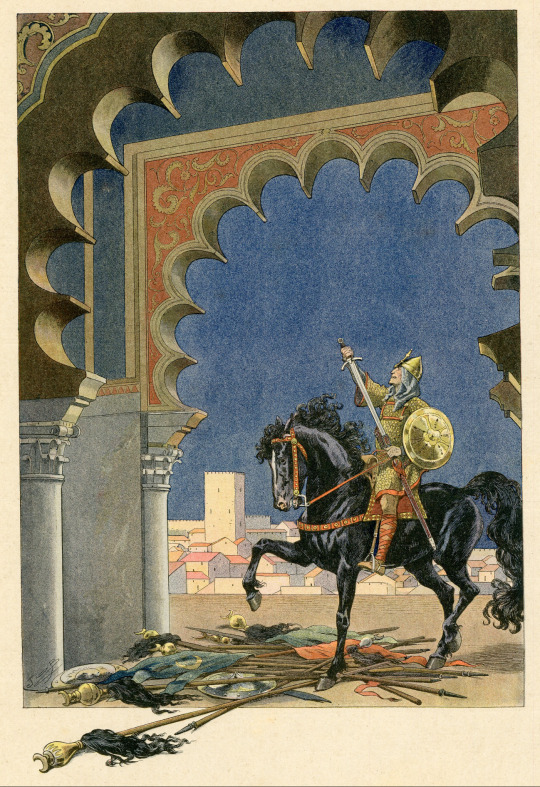
#jacques onfroy de bréville#job#art#illustration#spain#reconquista#el cid#el cid campeador#knights#knight#crusade#crusades#crusader#spanish#hispania#iberia#iberian peninsula#history#medieval#middle ages#chivalry#sword#europe#european#christianity#christian#christendom#mediaeval#reconquest#españa
186 notes
·
View notes
Text

Las Médulas
#aph spain#Hispania#historical hetalia#aph roman empire#If you squint#I was reading about these goldmines in a book about life during the Roman Empire I was not ready when I saw how they look I AM MINDBLOWN#No wonder Spain has an unhealty obsession with gold
81 notes
·
View notes
Text
The Jews of Spain: A History of the Sephardic Experience
"One particular folk tradition has lasted virtually to the present day: the legend that some of ancient Jerusalem’s aristocratic families, deported first by the Babylonians in 586 BCE and then again by the Roman conqueror Titus in 70 CE, resettled on the Spanish shore."
Una tradición popular en particular ha perdurado prácticamente hasta el día de hoy: la leyenda de que algunas familias aristocráticas de la antigua Jerusalén, deportadas primero por los babilonios en 586 a.C. y luego nuevamente por el conquistador romano Tito en 70 d.C., se reasentaron en las costas españolas.
"These and similar traditions attesting to the Sephardic community’s biblical origins were probably a form of self-defense, for most of them emerged when anti-Semitism was intensified during the Christian reconquest of Muslim Spain."
Estas y otras tradiciones similares que atestiguan los orígenes bíblicos de la comunidad sefardí probablemente fueron una forma de autodefensa, ya que la mayoría surgió cuando el antisemitismo se intensificó durante la reconquista cristiana de la España musulmana.
Gerber, Jane S. The Jews of Spain: A History of the Sephardic Experience Free Press, 1992.
#judaísmo#judaism#jewish#judío#cultura judía#ladino#sephardic#la reconquista#antisemitismo#reconquista cristiana#españa#españa musulmana#586#70 d.c.#586 a.c.#antisemitism#judíos#muslim spain#ispania#hispania#The Jews of Spain: A History of the Sephardic Experience#Jane S. Gerber#jerusalem#jerusalén
21 notes
·
View notes
Photo
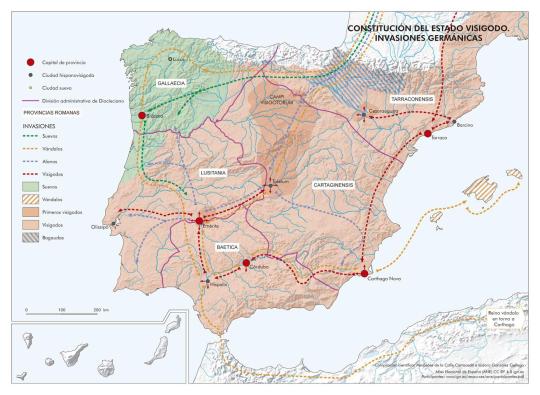
Barbarian invasions in Hispania after the fall of the Western Roman Empire
136 notes
·
View notes
Text
If anyone wants to read new historical fiction related to the Abd al-Aziz chapter of the Al Andalus. Historical Figures book, recently a novel has been published. This novel is Egilona, Reina de Hispania (Egilona, Queen of Hispania), writen by José Soto Chica. The bulk of the story is based on the texts of the Mozarabic Chronicle and Arabic sources such as the Fath al-Andalus codex, the anonymous Ajbar Maimu'a or the works of the historian Al-Maqqari and the caliph Al-Hakam. In fact, all chapters begin with a fragment of these writings.

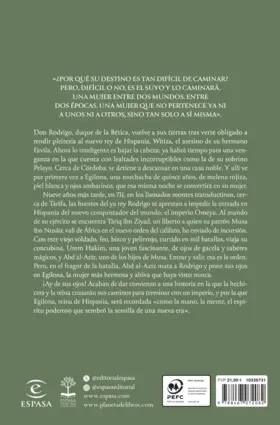
Synopsis
Egilona, the last queen of Hispania, a powerful woman between two cultures, between two eras, the Gothic and the Arab, fascinates us in this memorable historical novel.
Don Rodrigo, Duke of Bética, returns to his lands after being forced to pay homage to the new king of Hispania, Witiza, the murderer of his brother Favila. Now the smart thing is to lower his head; There will be time for revenge. Near Córdoba, he stops to rest in a noble house and there he sees for the first time Egilona, a fifteen-year-old girl with reddish hair, white skin and amber eyes, who that same night will become his wife.
Nine years later, in 711, near Tarifa, the hosts of the now king Rodrigo prepared to prevent the entry into Hispania of the new conqueror of the world: the Umayyad empire. In command of his army is Tariq ibn Ziyad, a freedman whom his patron Musa ibn Nusayr, vali of Africa in the new order of the caliphate, has sent on a raid. With this old soldier, ugly, cross-eyed and red-haired, hardened in a thousand battles, travels his concubine, Umm Hakim, a fascinating young woman, with doe eyes and magical knowledge, and Abd al-Aziz, one of Musa's sons. In and out, that's the order. But, in the heat of battle, Abd al-Aziz kills Rodrigo and sets his sights on Egilona, the most beautiful and haughty woman he has ever seen.
Woe to his eyes! They have just begun a story in which the sorceress and the queen will cross paths to end an empire, and for which Egilona, queen of Hispania, will be remembered "as the hand, the mind, the powerful spirit that sowed the "seed of a new era."
Some comments from the author of the novel about the historical figure of Egilona, the historical setting, the conquest and her marriage to Abd al-Aziz, from this interview:
"Events that have usually been told very poorly"
"She was a transitional character who was everything with the Visigoths and is everything again in the new world of the Muslims, but a lot of nonsense has been written about her"
"I have opted for an intermediate solution in the novel"
"After Rodrigo's death it stands as a symbol of resistance, but after the second defeat of the Visigoths in Écija I made Al-Aziz capture it. Let's think about Aztec Mexico: the Spanish were a very small force and they relied on the nobility. The Arabs did the same. This marriage was not the exception, but the norm, and there are the examples of Teodomiro's daughter or Witiza's granddaughters. It was a time when collaboration was needed"
"If I put on my historian's suit and limit myself to what the sources say, I am tied hand and foot. Now, a novelist does have licenses and I imagine that story of hate and love with Al-Aziz"
"But I think the result is very coherent: it is a novel by a historian who specializes in the period and which, literary speaking, proposes psychological solutions to the 8th century."
"For me, her forgetfulness is intentional from her own time: for those who resisted in Asturias she was a traitor; for the Arabs, she was responsible for the perfect Muslim warrior falling into the conspiracy. She was guilty for going over to the enemy or subverting the order, and this has greatly influenced nineteenth-century and current Spanish historiography"
"This novel, at the level of people who seek to learn history with fiction, is the story of the Islamic conquest of Hispania based on what we really know, which has changed a lot in the last twenty years"
"It's not about good ones and bad ones, but about people like us who have to survive by accepting that the world has changed or by rebelling against it."
#egilona reina de hispania#egilona queen of hispania#bookblr#historical fiction#novel#books#josé soto chica#queen egilona#ailo#king rodrigo#rodrigo king of the goths#abd al-aziz ibn musa#abd al aziz#musa ibn nusayr#tariq ibn ziyad#book scans related#hispania#al andalus#spania#rey don rodrigo#umm hakim
16 notes
·
View notes
Text


Warned of Chilperic’s playboy reputation, Athanagild had not immediately accepted Chilperic’s offer of marriage. Brunhild had converted from Arianism to Catholicism for Sigibert. Galswintha would also convert to her new husband’s preferred religion, but only on the condition that Chilperic be her faithful Christian husband. The Visigoths were much more prudish in this respect; their code prohibited the keeping of concubines and mistresses. And so Athanagild demanded Chilperic swear a solemn oath, a sacramentum, to repudiate all other women. Everyone would have understood who, exactly, Athanagild was referring to. This was the precondition to the marriage that Chilperic so eagerly sought: a king must swear to stay away from a slave. The fact that Chilperic was forced to make this particular promise hints that Fredegund’s hold over the king had already raised some eyebrows. There seems to have been no concern that his exiled first wife might return from her cloister – even though her three legitimate sons were being groomed to be warriors in their father’s armies – nor that any other of Chilperic’s former mistresses would dare disrespect this new powerful queen. But Fredegund, specifically, was perceived to be a potential problem. Chilperic agreed to this demand. He wanted this illustrious alliance more than he wanted any slave girl. He readily agreed that Fredegund would be sent away. But she would not be cast aside so easily. She kept her own counsel – and made her own plans.
Shelley Puhak, The Dark Queens: A gripping tale of power, ambition and murderous rivalry in early medieval

#fredegund#athanagild#atanagildo#chilperic#visigothics#merovingians#neustria#hispania#french history#spanish history
6 notes
·
View notes
Text
They are so South European core❤️🩹


4 notes
·
View notes
Text

Mosaico de los Amores, Spain
#archaeology#mosaic#spain#art#jaén#andalucía#history#antiquity#cástulo#roman#ancient rome#ancient world#mosaics#europe#european#iberian peninsula#iberia#hispania#linares#floors#tiles#archaeologist#mosaico de los amores#mosaico#photography#photograph
406 notes
·
View notes
Photo
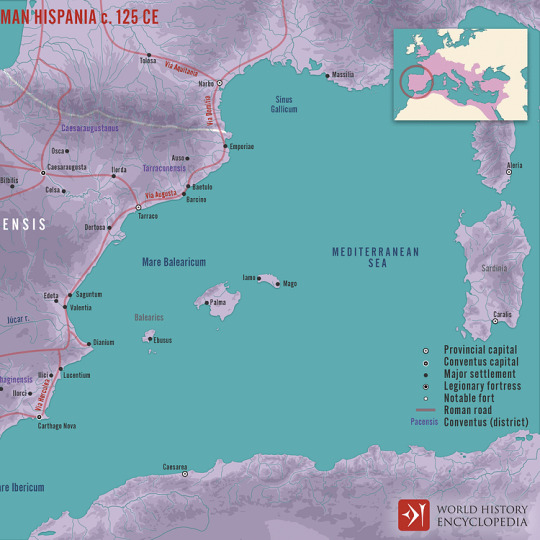
Roman Hispania c. 125 CE
A map illustrating the scope and organization of the Roman provinces in Hispania (present-day Spain and Portugal.) Roman Spain was one of the first provinces beyond Italy; it took two centuries to conquer fully (starting with an invasion against the Carthaginians in 206 BCE) and remained under Roman rule far longer than most of the Western Empire (northeastern Spain was still under nominal Roman control c. 474 CE.) Hispania was among the wealthiest and most Romanized of the empire’s provinces for over 500 years.
42 notes
·
View notes
Text
Coin of the Day #77 (7/20/2024)
How about a Hispanic Roman provincial?


Roman Province - Hispania Baetica
AE22 - 6.00g
Augustus 27 BC - 14 AD
Patricia Mint
Obverse PERM CAES AVG
Head of Augustus left
Reverse COLONIA PATRICIA
Apex and simpulum
RPC I 130
#coin of the day#roman empire#roman province#hispania#baetica#hispania baetica#patricia#colonia patricia#augustus#octavian#roman coins#coin#coins#numismatics#ancient rome#ancient coins
2 notes
·
View notes
Text
The Jews of Spain: A History of the Sephardic Experience
"Migration of Jews throughout the Roman diaspora (c. 200 BCE-200 CE) was so widespread that the ancient Greek geographer Strabo reportedly exclaimed, ‘This people has already made its way into every city, and it is not easy to find any place in the habitable world which has not received this nation and in which it has not made its power felt’ (Josephus, Antiquities, XTV, 115)."
La migración de los judíos a lo largo de la diáspora romana (c. 200 a.C.-200 d.C.) fue tan generalizada que, según se informa, el antiguo geógrafo griego Estrabón exclamó: "Este pueblo ya se ha establecido en cada ciudad, y no es fácil encontrar un lugar en el mundo habitable que no haya recibido a esta nación y en el que no haya hecho sentir su poder" (Josefo, Antigüedades, XIV, 115).
"Jewish merchants and travelers followed the expansion of Phoenician and Syrian trading colonies all along the shores of the Mediterranean, certainly including the Iberian peninsula."
Los comerciantes y viajeros judíos siguieron la expansión de las colonias comerciales fenicias y sirias a lo largo de las costas del Mediterráneo, incluyendo ciertamente la península ibérica.
"Jews in the Roman diaspora flourished in some measure because the Empire recognized Judaism as a legal religion (religio licita)."
Los judíos en la diáspora romana prosperaron en cierta medida porque el Imperio reconoció el judaísmo como una religión legal (religio licita).
"Rome also continued to recognize the Jewish cultural ties to their national homeland in Palestine even after the great Jewish revolts there in the first and second centuries."
Roma también continuó reconociendo los lazos culturales judíos con su patria nacional en Palestina incluso después de las grandes revueltas judías en los siglos I y II.
#The Jews of Spain: A History of the Sephardic Experience#Jane S. Gerber#judaísmo#judaism#jewish#judío#antisemitismo#sephardic#sefardí#cultura sefardí#historia sefardí#roma#cultura judía#palestina#revueltas judías#siglo i#siglo ii#comerciantes judíos#diáspora#españa#ispania#hispania#migración judía#sephardic history#judíos
13 notes
·
View notes
Photo
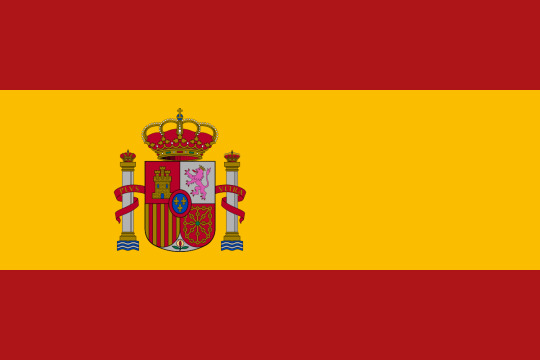

Why is Spain called Spain (Espagna)?
The ancient Phoenicians who arrived to trade with the peoples of the peninsula called it Sphaniam (land of rabbits), the Greeks that arrived to trade with our city states called it Iberia for the river Iber who is a plentiful large river with a large delta at the end. The Greeks eventually adopted Spania for the place and Iberians for the people. Later the Romans took the name into Latin Hispania. Hispania became España in Spanish and Espagne in French, Espagne became Spain imported to English.

#sphaniam#espana#espagne#spain#english#french#hispania#romans#latin#greeks#helen#iberia#iber#phoenicians#europeans#western european#western europe#europe#europa
25 notes
·
View notes
Text

"The Death of Viriathus Leader of the Lusitanians".
- Jose de Madrazo, Prado Museum.
#Viriathus#Celts#Iberia#Celtiberians#Lusitanians#indo-Europeans#europe#Viriato#Vercingetorix#Rome#Roman empire#cu chulainn#Lusitanian wars#hispania#falcata#iberian devotio#Iberian salute#Spanish Celts#Celtic Spain#Celtic Iberia#R1b
24 notes
·
View notes
Text
Now that Hallowen is near, I have decided to share an interesting book I have been reading in these weeks, its title is Toledo: La Ciudad de los Muertos (Toledo: The City of the Dead), writen by Ventura Leblic García. The topic is to divulge about the stories and death rites of people of the several cultures and religions which have inhabitated the city throughout history. I'll be sharing scans of the pages of the book through posts here on Tumblr if anyone it's curious about the topic. Here's the first set:
PART 1

Cover
Toledo: The City of the Dead
Ventura Leblic García
Covarrubias Editions
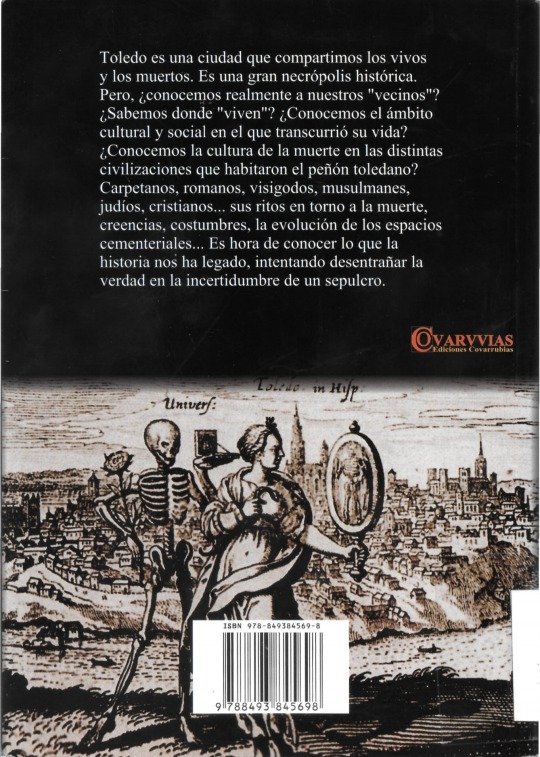
Backcover
Toledo is a city that the living and the dead share. It is a great historical necropolis. But do we really know our "neighbors"? Do we know where they "live"? Do we know the cultural and social environment in which their lives were spent? Do we know the culture of death in the different civilizations that inhabited the crag of Toledo? Carpetans, Romans, Visigoths, Muslims, Jews, Christians... their rites around death, beliefs, customs, the evolution of cemetery spaces... It is time to know what history has left us, trying to unravel the truth in the uncertainty of a tomb.
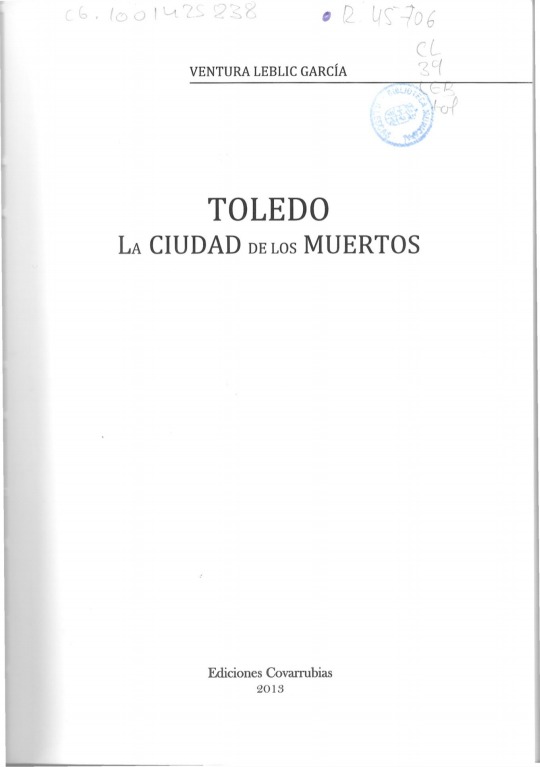
Toledo: The City of the Dead
Ventura Leblic García
Covarrubias Editions 2013

INDEX
Introduction. Page 9
Chapter I. Funerary practices in ancient times. Page 12
The indigenous people. Page 14
Chapter II. The cemetery spaces outside the walls of Toledo. Page 19
Roman cemeteries. Page 19
The early Christian cemetery. Page 24
Visigoth times. Page 31
Toledo's maqbara. The Muslim cemetery. Page 38
Toledo's Mozarabic cemeteries. Page 47
The Jewish cemetery. Page 50
Chapter III. The interior of churches as cementary spaces. Page 63
Chapter IV. Parish cemeteries. Page 70
Chapter V. The cemetery and the municipal cemetery. Page 103
Chapter VI. Royal burials in Toledo. Page 112
The New Kings Chapel. Page 136
New chapel. Page 139
Royal funerals in Toledo. Page 144
Chapter VII. Tombs of royal lineage in Toledo. Page 149
Chapter VIII. Other tombs in Toledo of people who made history. Page 170
The tomb of Doménikos Theotokópoulos "El Greco". Page 178
A frustrated pantheon of illustrious men. Page 182
Don Álvaro de Luna and Doña Juana de Pimentel. Page 188
An empty tomb for four hundred years. Page 191
The tomb of Cardinal Mendoza. Page 194
Francisco de Pisa. Page 196
The flying priest. Bartolomeu Lourenço de Gusmão. Page 197
Chapter IX. The Cistercian monastery of Monte Sión. A case of pantheon foundation. Page 201
The graves. Page 204
Chapter X. Bodies of saints and blesseds venerated in Toledo. Page 215
Chapter XI. Those who did not return. Page 232
Saint Ildefonso of Toledo. Page 232
Grave of Alfonso VI, king of Castile. Page 237
Alfonso X the Wise. Page 239
Francisco Jiménez de Cisneros. Page 240
Queen Joanna I of Castile. Page 242
Alfonso III de Fonseca, archbishop of Toledo. Page 243

Juan de Padilla. Page 244
Francisco de Rojas. Page 248
Cardinal Lorenzana. Page 249
Bibliography. Page 251
#books#toledo la ciudad de los muertos#toledo the city of the dead#ventura leblic garcía#history#pre-roman history#carpetan history#roman history#visigothic history#carpetania#hispania#jewish history#sefarad#sepharad#muslim history#al andalus#christian history#death rites#ancient history#medieval history#modern history#part 1#toledo#carpetan culture#roman culture#visigoth culture#christian culture#jewish culture#islamic culture#carpetans
2 notes
·
View notes
Text

👕👕👕 PRÓXIMAMENTE.........
#mendezilustracion#almeriaartistica#art#illustration#artists on tumblr#illustrator#ilustracion#illustrators on tumblr#dibujo#almeriaart#terciosviejosespañoles#terciosdeespaña#terciosdeflandes#tercios#tercio#hispania#historiadeespaña#historiaespaña#historiamilitar#camisetasdivertidas#camisetaspersonalizadas#camisetaschulas#camisetas#camiseta#ejercitoespañol🇪🇸#ejercitoespañol#vivaespaña#defiendeespaña#defend europe#españagram
3 notes
·
View notes
